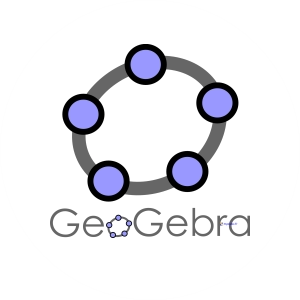
-
GeoGebra – Detailed Explanation : A tool for mathematics, geometry, and analysis.
GeoGebra is a dynamic mathematics software that combines geometry, algebra, spreadsheets, graphing, statistics, and calculus. It’s widely used in educational settings to help students understand mathematical concepts through interactive and visual learning.
1- On which platform are the tools used?
GeoGebra is available across multiple platforms:
- Web-based: Accessible through any modern web browser via the official website GeoGebra.org.
- Desktop: Available for Windows, macOS, and Linux as downloadable applications.
- Mobile: GeoGebra offers apps for iOS and Android devices, providing flexibility to access tools on smartphones and tablets.
2- What hardware requirements are needed?
Hardware Requirements:
GeoGebra is lightweight and can run on most modern devices.
- Operating System: Windows 7 or later, macOS 10.9 or later, Linux, or mobile devices with iOS 9.0 or later / Android 5.0 or later.
- Processor: 1.5 GHz or higher.
- RAM: 2 GB or more recommended for smooth performance.
- Storage: 200 MB or more of available disk space for desktop applications.
- Graphics: Integrated graphics are sufficient; more advanced hardware may be needed for complex 3D visualizations.
- Internet: Required for web-based use or syncing projects across devices (cloud-based saving).
3- Installation and membership stages
Installation Process:
- Web Version:
No installation is needed. Simply go to the GeoGebra website and start using the tools directly in the browser. - Desktop Version:
Download the appropriate application for Windows, macOS, or Linux from the GeoGebra website and follow the installation instructions. - Mobile Version:
Download the app from the App Store (for iOS) or Google Play (for Android) to get started.
Membership Stages:
GeoGebra is free to use. However, users can create an account to:
- Save their work in the cloud.
- Share and collaborate on activities with other users.
- Access additional resources, like GeoGebra’s math community, for sharing and discussing ideas.
There are no mandatory membership fees, but account registration allows more features like storing projects online and tracking progress.
4- What can it be used for?
GeoGebra can be used in a variety of mathematical and educational applications:
- Geometry:
Visualize geometric shapes, create constructions, and explore properties of figures dynamically. - Algebra:
Use GeoGebra to perform algebraic operations, graph functions, and visualize the connections between algebraic expressions and geometric objects. - Calculus:
Perform calculations like derivatives and integrals, as well as graphing them in 2D and 3D. - Statistics:
Create statistical charts, histograms, and regression models for data analysis. - Spreadsheet:
Use GeoGebra’s spreadsheet interface to manage and analyze data, just like Excel. - 3D Graphing:
Visualize and interact with 3D functions and geometric shapes. - Mathematical Exploration and Learning:
Teachers and students use GeoGebra to explore concepts interactively, making abstract math more tangible and easier to understand.
5- What is its prominent feature compared to other tools?
Prominent Features of GeoGebra:
- Integrated Dynamic Mathematics:
Unlike many other tools, GeoGebra integrates geometry, algebra, calculus, and statistics in one platform. This dynamic interactivity allows students to see the direct relationship between different mathematical areas in real-time. - User-Friendly Interface:
GeoGebra offers a clean, intuitive interface that is easy for students and teachers to navigate. It also supports both beginner and advanced users with different levels of complexity in tools. - Interactive Graphing:
The ability to manipulate points, curves, and other geometric objects dynamically makes learning and teaching math highly interactive and engaging. - 3D Graphing and Geometry:
GeoGebra stands out with its powerful 3D graphing and modeling tools that allow users to explore multidimensional spaces visually. - Global Collaboration and Sharing:
GeoGebra supports a large online community where users can share their work, discuss ideas, and access thousands of pre-made activities.
6- Sample application made with pictures
Example: Interactive Geometry Lesson – Pythagorean Theorem
Step-by-Step Process:
- Create a Right-Angled Triangle:
Use the Polygon Tool to create a right-angled triangle on the plane, making sure to label the sides with different colors. - Add Squares on Each Side:
Use the Polygon Tool again to draw squares on each side of the triangle to visually represent the Pythagorean theorem. - Manipulate the Triangle:
Drag the points of the triangle to change its size and shape. GeoGebra will automatically update the areas of the squares as the triangle changes, visually demonstrating the relationship a2+b2=c2a^2 + b^2 = c^2. - Show the Calculation:
Add text boxes and input fields to display the algebraic formula, showing how the area of the squares relates to the sides of the triangle. - Interactive Demonstration:
The lesson is now interactive, allowing students to manipulate the triangle and see the equation in action.
7- Which courses can it be used in and is compatible with?
GeoGebra is compatible with a variety of educational fields, particularly in the mathematics and STEM disciplines:
- Mathematics:
- Algebra
- Geometry
- Trigonometry
- Calculus
- Statistics
- Probability
- Linear Algebra
- Engineering and Design:
Use GeoGebra for simple engineering designs, especially for concepts related to geometry, angles, and transformations. - Physics:
Visualize concepts like motion, forces, and energy in physics through interactive graphs and models. - STEM Education:
GeoGebra is widely used in K-12 and higher education settings to teach fundamental STEM concepts.
8- Is it free?
Yes, GeoGebra is completely free to use. There are no charges for accessing any of its tools, and users can create, save, and share their projects without a paid subscription.
9- Links related to GeoGebra
- Official Website: GeoGebra
- GeoGebra Classroom: GeoGebra Classroom
- GeoGebra Resources & Community: GeoGebra Forum
- GeoGebra Download Page: GeoGebra Downloads
- GeoGebra YouTube Channel: GeoGebra on YouTube
GeoGebra stands as an invaluable educational tool for anyone studying or teaching mathematics. Its ability to integrate multiple branches of math and its interactive approach to learning make it a powerful and accessible platform for both students and educators. Whether you’re visualizing geometric properties or solving calculus problems, GeoGebra simplifies complex mathematical concepts and encourages hands-on learning.